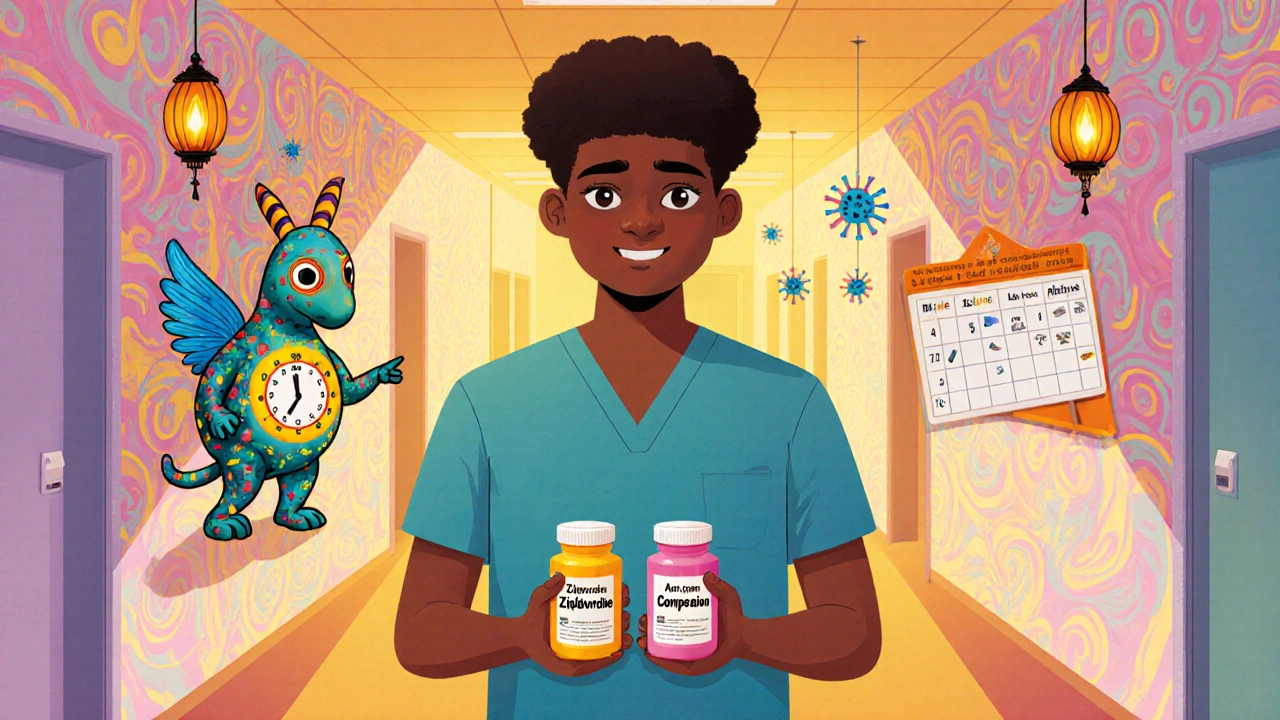HIV Treatment Adherence Calculator
Calculate Your Adherence Impact
Your Treatment Outcomes
CD4 Cell Recovery
Approximately 150 cells/µL increase (based on 95% adherence)
Viral Suppression Probability
When you hear the word “adherence” in an HIV clinic, you’re really talking about a patient’s ability to take their medicines exactly as prescribed. Miss a dose, and the virus can rebound, resistance can develop, and long‑term health suffers. One of the oldest drugs in the antiretroviral arsenal, zidovudine, still shows up in modern regimens, especially in resource‑limited settings. But how does it shape a patient’s daily routine, and what does that mean for the final health outcomes? Let’s break it down.
What is Zidovudine?
Zidovudine is a nucleoside reverse transcriptase inhibitor (NRTI) that was the first drug approved for HIV infection in 1987. It works by mimicking the natural nucleoside thymidine, getting incorporated into viral DNA and halting chain elongation. Over the decades, its chemistry has been refined, but the core mechanism remains unchanged.
Because it was the pioneer, zidovudine set the stage for the combination therapy we call antiretroviral therapy (ART). Its early success proved that a virus could be chemically crippled, leading to the “triple‑drug” era that now dominates HIV care.
Where Zidovudine Fits in Modern ART Regimens
Today, most patients are on a single daily pill that combines two or three agents. Zidovudine is usually paired with another NRTI such as lamivudine, and a third‑class drug (NNRTI, PI, or INSTI). In high‑income countries, clinicians often prefer newer NRTIs like tenofovir because they have a better side‑effect profile. However, the World Health Organization (WHO) still lists zidovudine as a first‑line option for patients who cannot tolerate tenofovir, especially pregnant women or those with renal impairment.
Understanding its role helps explain why adherence factors differ from those of newer agents. Zidovudine’s dosing schedule, side‑effect burden, and resistance patterns all feed into the patient’s day‑to‑day experience.
How Zidovudine Influences Adherence
- Dosing frequency: Zidovudine typically requires twice‑daily dosing (every 12 hours). In contrast, tenofovir‑based combos can be taken once daily. The extra pill‑taking event can feel like a hassle, especially for patients with busy lives.
- Side‑effects: Common complaints include nausea, fatigue, headache, and anemia. Anemia can be severe enough to require dose reduction or blood transfusion, which scares patients and pushes them to skip doses.
- Pill burden: While the drug itself is a single tablet, many regimens that include zidovudine also add other NRTIs, raising the total number of pills per day.
- Stigma & visibility: Twice‑daily dosing can force patients to take medication in public or work settings, increasing the risk of accidental disclosure.
All these factors stack up, creating a higher risk of missed doses compared with newer, once‑daily agents.

Clinical Outcomes Tied to Adherence
Adherence isn’t just a behavioral metric; it directly impacts measurable health outcomes:
- CD4 count recovery: Studies from the International Epidemiology Databases to Evaluate AIDS (IeDEA) show that patients on zidovudine‑based regimens who maintain ≥95 % adherence see an average CD4 rise of 150 cells/µL in the first year. Those dropping below 80 % adherence only gain about 50 cells/µL.
- Viral load suppression: The threshold for undetectable viral load (<50 copies/mL) is reached in 68 % of adherent patients versus 42 % of non‑adherent patients on zidovudine regimens.
- Mortality and opportunistic infections: A 2023 cohort from South Africa linked poor adherence to a 1.8‑fold increase in AIDS‑related mortality among zidovudine users.
- Drug resistance: Inconsistent dosing allows the virus to replicate in the presence of sub‑therapeutic drug levels, fostering the M184V and K65R mutations that reduce zidovudine efficacy.
These numbers illustrate why clinicians spend so much time counseling patients about taking every dose.
How Zidovudine Stacks Up Against Other NRTIs
| Drug | Dosing Frequency | Typical Side‑effects | Adherence Impact | Resistance Barrier |
|---|---|---|---|---|
| Zidovudine | Twice daily | Nausea, anemia, fatigue | High (needs strict schedule) | Low‑medium |
| Lamivudine | Once daily | Headache, mild GI upset | Medium | Low |
| Tenofovir disoproxil fumarate | Once daily | Renal toxicity, bone loss | Low (once‑daily easier) | High |
From the table you can see why zidovudine generally scores higher on the “adherence impact” axis: twice‑daily dosing and more pronounced side‑effects make it tougher to stay on track.
Managing Side‑effects to Boost Adherence
Clinicians have a toolkit to keep patients from dropping off:
- Baseline labs: Check hemoglobin and liver enzymes before starting. If anemia appears, consider dose reduction or switching to an alternative NRTI.
- Symptom‑focused counseling: Explain that nausea often improves after two weeks; offer anti‑emetics like ondansetron for the first month.
- Nutrition support: Iron‑rich foods and vitamin B12 can mitigate anemia.
- Adherence aids: Alarm‑based mobile apps, pillboxes with twice‑daily compartments, or text‑message reminders have shown a 15‑20 % uplift in dose‑taking for zidovudine patients.
When side‑effects are tackled head‑on, adherence rates climb, which in turn improves viral suppression and CD4 recovery.

Practical Tips for Patients and Providers
Here’s a quick cheat‑sheet you can hand out at the clinic:
- Take zidovudine at the same two times every day (e.g., 7 am and 7 pm). Set a phone alarm.
- Pair each dose with a small snack to lessen nausea.
- Track side‑effects in a journal; bring the list to every follow‑up.
- Get blood work every 3 months to catch anemia early.
- If you miss a dose, take it as soon as you remember unless the next dose is within 8 hours; then skip the missed one and continue on schedule.
- Talk openly with your care team about any barrier-work schedule, stigma, or side‑effects.
These concrete steps turn abstract adherence advice into everyday actions.
Future Outlook: Is Zidovudine Here to Stay?
Long‑term data from the PARTNERS study (2022‑2024) suggest that, when paired with a high‑barrier third‑class drug like dolutegravir, zidovudine can still achieve >90 % viral suppression in adherent patients. Yet, the global push toward once‑daily, low‑toxicity combos means its market share will keep shrinking.
For now, though, many low‑resource clinics rely on zidovudine because it’s cheap, stable at room temperature, and included in the WHO’s essential medicines list. That reality keeps the adherence question relevant for years to come.
Frequently Asked Questions
Can I take zidovudine with food?
Yes. Taking it with a small snack reduces nausea and helps maintain steady blood levels.
What should I do if I miss a dose?
If it’s been more than 8 hours, take the missed pill right away. If less than 8 hours, skip it and stick to the next scheduled dose.
Why is anemia a concern with zidovudine?
Zidovudine can suppress bone‑marrow production of red blood cells. Regular blood tests catch drops early, allowing dose adjustment before symptoms worsen.
Is zidovudine safe during pregnancy?
Yes. It’s one of the few NRTIs classified as pregnancy‑category B, meaning benefits outweigh potential risks. Still, doctors monitor fetal growth closely.
How does zidovudine resistance develop?
When a patient skips doses, viral replication occurs in the presence of low drug levels, selecting for mutations like M184V. These mutations reduce zidovudine’s binding to reverse transcriptase, making the drug less effective.

Janet Morales
October 18, 2025 AT 17:40Oh great, another love‑letter to zidovudine while people still have to wrestle with twice‑daily dosing and that dreaded anemia‑induced fatigue. It’s like forcing a marathon runner to wear ankle weights-sure, the drug works, but at what cost to daily life? The side‑effect profile alone should make clinicians think twice before slapping it on a new patient.
Albert Fernàndez Chacón
October 18, 2025 AT 19:03Honestly, the anemia thing can be a real deal‑breaker. In many clinics we see patients need regular blood checks, and a drop in hemoglobin often forces a dose cut‑back, which then jeopardizes viral suppression. Plus, the extra pill‑time in the middle of the workday can feel like an unwanted spotlight.
Drew Waggoner
October 18, 2025 AT 20:27Skipping doses because you’re scared of a blood test just feeds the virus, no doubt. The moment you let the drug levels dip, resistance mutations pop up faster than rumors on a gossip forum.
Mike Hamilton
October 18, 2025 AT 23:13When you look at the history of HIV therapy, zidovudine stands out as the pioneer that opened the door for combination regimens. It was the first drug that showed a virus could be tamed, and that promise sparked a wave of optimism worldwide. Yet, the optimism was tempered by the harsh reality of its dosing schedule – twice a day, without mercy. Patients in low‑resource settings often have to align their medication with meals, work shifts, and even prayer times, which creates a constant juggling act. The side‑effects, especially anemia, are not just lab numbers; they manifest as persistent tiredness, shortness of breath, and sometimes the need for blood transfusions. Those transfusions are not only costly but also add a layer of stigma that many patients would rather avoid. Moreover, the pill burden can be deceptive: while zidovudine itself is a single tablet, it is usually paired with other NRTIs, pushing the daily count upward. This increase in tablets can amplify the feeling of being a “patient” rather than a person going about their day. In many cultures, taking medication in public is still seen as a sign of illness, and the twice‑daily requirement forces people into awkward situations at work or school. The psychological toll of that visibility can erode adherence just as much as the physical side‑effects. Studies from the IeDEA network have repeatedly shown that adherence rates above 95 % are needed to see meaningful CD4 recovery, something hard to achieve with a regimen that demands strict timing. On the flip side, when patients do manage to stay on schedule, zidovudine can still deliver solid viral suppression, proving its durability despite newer alternatives. The drug’s stability at room temperature also makes it a lifesaver in places without reliable cold chains. That practical advantage keeps it on WHO’s essential medicines list, even as newer, more tolerable drugs enter the market. So while the future may belong to once‑daily, low‑toxicity combos, zidovudine remains a critical bridge for many communities worldwide today.
Liberty Moneybomb
October 19, 2025 AT 00:37Did you ever wonder why the big pharma giants keep pushing tenofovir when zidovudine is practically free? It’s like they’re hiding a secret agenda to keep patients dependent on expensive “brand‑new” meds while the old reliable gets shoved to the back of the shelf.
kendra mukhia
October 19, 2025 AT 02:00That’s a classic conspiracy line, but the reality is far more pragmatic – WHO guidelines are based on cost‑effectiveness studies, not some shadowy boardroom plot.
Bethany Torkelson
October 19, 2025 AT 03:23Enough with the textbook talk; the real problem is that clinicians often overlook how a twice‑daily regimen shatters a patient’s routine, leading to missed doses and eventual treatment failure.
Grace Hada
October 19, 2025 AT 04:47Patients deserve regimens that respect their time; if a drug forces them to set alarms at midnight, it’s a design flaw, not a therapeutic necessity.
alex montana
October 19, 2025 AT 06:10zidovudine-still used; still problematic.
Wyatt Schwindt
October 19, 2025 AT 07:33Monitoring hemoglobin levels regularly is essential when prescribing zidovudine to catch anemia early.
Rohit Sridhar
October 19, 2025 AT 08:57Let’s keep supporting clinics with training on adherence counseling so patients can manage the twice‑daily schedule without feeling overwhelmed.
Sarah Hanson
October 19, 2025 AT 10:20In conclusion, while zidovudine remains a valuable component of antiretroviral therapy in specific contexts, its dosing frequency and hematologic side‑effects necessitate vigilant clinical oversight.
Nhasala Joshi
October 19, 2025 AT 11:43Watch out! The hidden agenda behind zidovudine distribution is as clear as a cloudy day 🌧️ – they want us to stay sick so they can profit forever 😈.
Brian Van Horne
October 19, 2025 AT 13:07From a pharmacological standpoint, zidovudine’s mechanism of chain termination is elegant, yet the practical challenges of adherence remind us that drug design must go hand‑in‑hand with patient‑centered delivery.